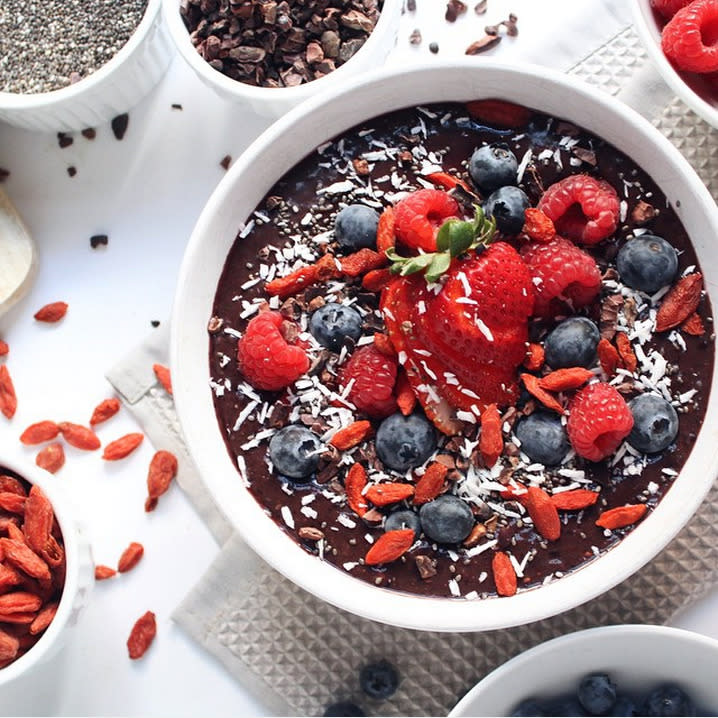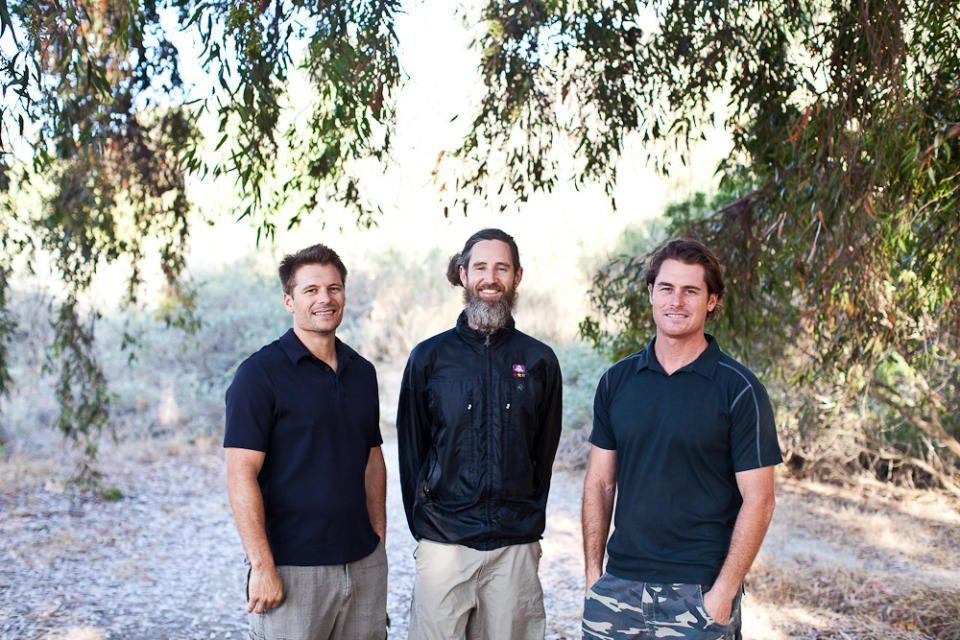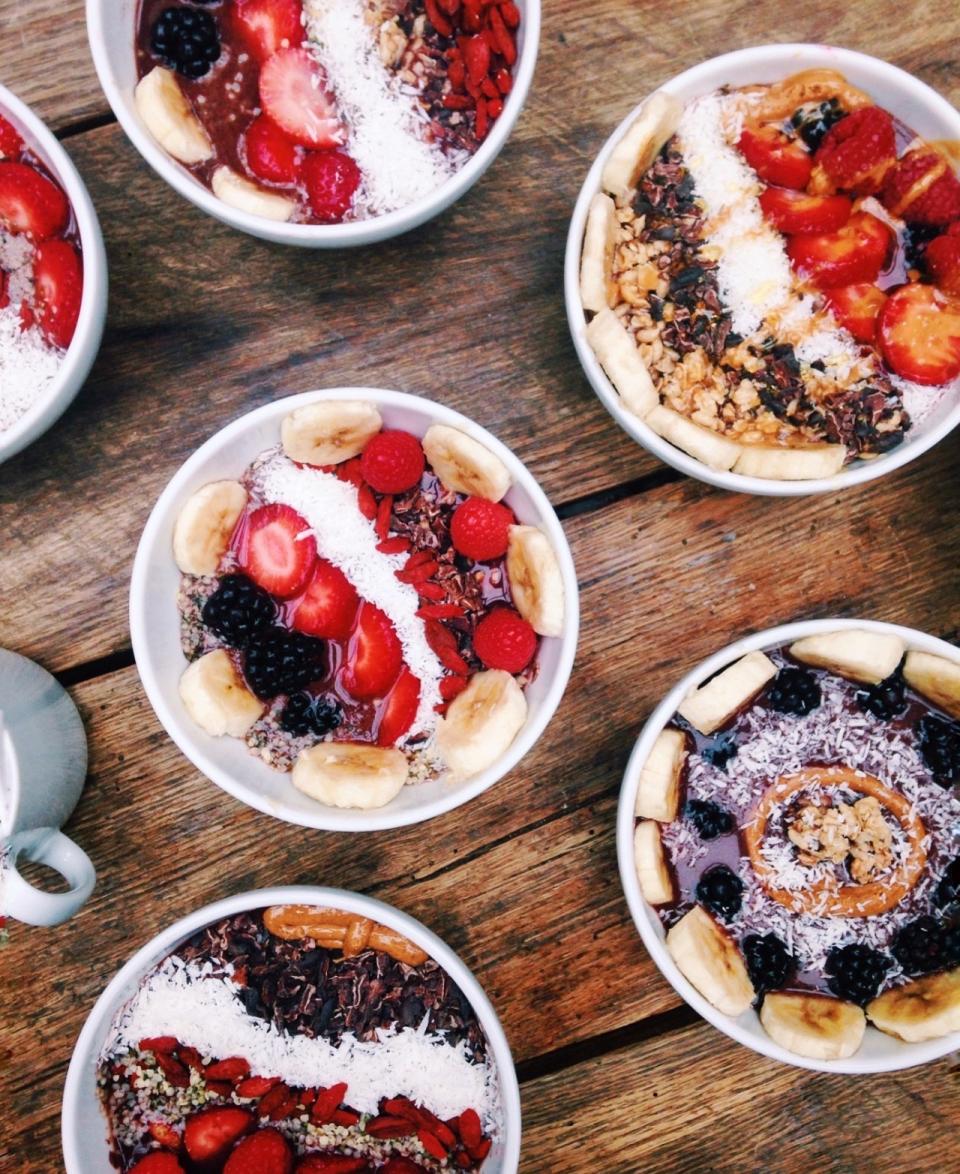How Two Brothers Overcame Internet Hype to Bring Açaí to the Masses

A lush bowl of acai topped with berries and coconut. Photo courtesy of Sambazon.
If you’ve scrolled through your Instagram feed recently, you’ve probably seen them: vibrant violet breakfast bowls topped carefully with bright rows of berries, banana slices, and a cavalcade of seeds like chia, flax, and sunflower. Health gurus and hip cafes alike have enthusiastically embraced the açaí bowl for its nutritional powers and artful appearance. And unbeknownst to most, behind this superfood movement is one company — and two brothers — which had a passion for the purple fruit long before Instagram came into existence.
Though Sambazon co-founders Ryan and Jeremy Black now spend much of their time thinking about how what we eat affects our bodies and our planet, their upbringing was far removed from the food world. “We were part of the fast-food generation — french fries were considered vegetables,” Ryan says. Raised in Southern California, the brothers were always athletes; Ryan played American football professionally in European leagues and both were life-long surfers. However, their mentality toward food revolved around functionality and convenience, rather than sustainability, nutrition, or flavor. “As a football player, I ate with a purpose,” Ryan says, “to make my body bigger and stronger.”
More: Eat Your Superfoods - How to Make an Açaí Bowl
Though Ryan was exposed to the organic and natural food movement while studying at the University of Colorado in Boulder, it wasn’t until a fateful trip to Brazil in 1999 that his views toward food experienced a dramatic evolution. While visiting a small port town with friend and Sambazon co-founder Ed Nichols, Ryan discovered a snack popular with the local surfers refueling after a day riding the waves — the açaí bowl. “It was this whole, natural food full of healthy fats and antioxidants, and flavor. I loved the flavor of it and the feeling and energy I got from it,” he says. Açaí was seemingly a local secret, and, because of its perishable nature, had not yet found its way outside of the Amazon. Going back day after day for the healthful and addictive bowls, a light went on in Ryan’s head: “If açaí pulp could make it to this little island, surely it could reach America.”

Sambazon founders Ryan Black, Ed Nichols, and Jeremy Black (Photo courtesy of Sambazon).
After returning from his trip, Ryan told Jeremy — who had attended Pepperdine University and admittedly frequented fast food joints as a money saving measure — of his plan to bring the powerful fruit stateside. At first, Jeremy was skeptical. “The idea of selling this super-perishable crop that needed to be shipped frozen sounded difficult,” Jeremy says, but after his first velevety bowl of açaí he was hooked — not only on the Amazonian fruit, but on healthy eating as a whole.
After working with local harvesters and distributors in the Amazon on a way to get the frozen pulp to the states, by April of 2001 the brothers were ready to hit the streets of their hometown of Palo Alto, Calif., to deliver samples to juice bars and sell their smoothie packs one spot at a time. Soon, requests started flowing in, not only from interested businesses but by customers from New York to Miami who had tried their first açaí bowl and wanted to know where they could find it locally to make bowls at home. Their business grew, slowly but surely, and it experienced a major boost in 2004 when Nicholas Pericone, a dermatologist who wrote the bestselling “Pericone Promise,” called açaí the “#1 superfood in the world. “That put us on the map overnight,” Ryan says.
More: 4 New Superfoods to Discover Now
Now, 15 years later, Sambazon is not only the leading distributor of açaí in the world, but it also has a thriving branded business with many successful products from bottled smoothies to pints of purple sorbet — all while maintaining its core mission, which they call the “Triple Bottom Line.”
“The Triple Bottom Line measures success economically, environmentally, and socially. Where does your food come from, how does it impact the people that harvest it, is it organic and fair-trade, and is the business doing the right thing?” Jeremy says. Inspired by other “social entrepreneurs” who actively gave back to their communities — such as those behind The Body Shop and Ben and Jerry’s — the Blacks wanted to make sure they “were doing the right thing and had integrity and positive intentions at every stop,” Jeremy says.

Photo courtesy of Sambazon.
The brothers built their manufacturing plant in the Amazon rainforest, allowing them to employ hundreds of people from the local community. In the Brazilian harvest offseason, when many locals are at a loss for work, the Blacks helped to build schools and community and health programs. “We look at them as our family. We manage the land and take care of the forest. We pay fair trade wages and makes sure we’re reinvesting in the community,” Ryan says. On top of that, Sambazon’s fair trade partnership has allowed them to protect the rainforest while benefiting 10,000 family farmers simultaneously. However, with every success story comes setbacks, and ironically for Sambazon, theirs was perhaps the same thing that made “açaí” a household name. Around 2010, Internet weight loss scammers caught on to the powerful nutritional elements of açaí and began to market the “magical” power of the berry. “It was smoke and mirrors,” Ryan says, “and made açaí a buzzword for all things healthy and purple.” Soon, the superfood was being touted as a miracle get-fit quick ingredient that changed the likes of shampoo and gummy bears into unrealistic weight loss aids.
Unfortunately for Sambazon, a company trying to represent the authentic benefits of açaí, at the time this reputation did more harm than good. “All that severe overhype lead to weird associations, because people thought it was some trick to lose weight quick, which was never the intention,” Jeremy says. Thankfully for the Blacks, the frenzied açaí hype has died down and left in its wake an opportunity for Sambazon to promote açaí’s authentic nutritional benefits.
More: Antioxidant-Rich Berries Beyond Blueberries
“When people experience something like an açaí bowl, it changes the way they think about healthy food,” Jeremy says. Though açaí is a nearly “zero-sugar fruit,” its omega fat content makes it rich and creamy, making it the perfect match for blended bowls. Additionally, all Sambazon products are certified organic, non-GMO, fair-trade, and vegan. “Açaí is a gateway food. You don’t have to compromise taste to be nutritious, refreshing, and functional,” Ryan says.
Moving forward, the brothers have somewhat lofty ambitions: Change the way we eat and do business. “We believe in organics because they’re better for the environment and the planet. The more we harvest in our sustainable supply chain, the more positive impact we have on public health, and the environment of the amazon rainforest,” Ryan says, “Simply, we’re just trying to put purple smiles on everybody.”
To make your own simple açaí bowl, follow the simple recipe below. Sambazon products are available at nationwide at Costco, Sprouts, Whole Foods, Kroger, Publix and Safeway.

Photo: Gillie Houston for Yahoo Food.
2 Sambazon Original Smoothie Packs
½ banana
1/8 c apple juice
Blend all ingredients until smooth. Scoop into a bowl and top with granola and fruit of your choice.

